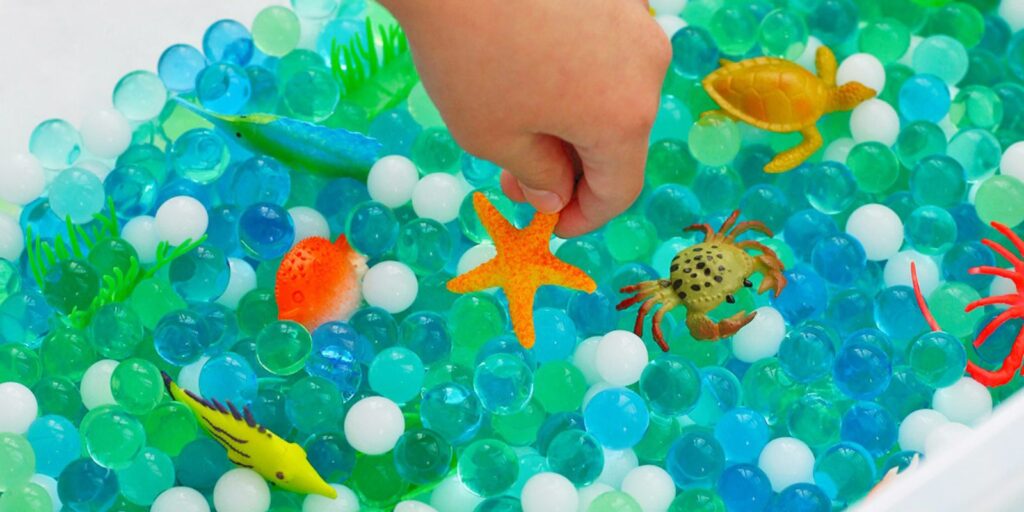Sensory Bin Ideas for Babies + Toddlers
Sensory bins are a great tool to have in your parent kit for long-lasting independent play (also known as: living the dream). They give kiddos the opportunity for self-directed unstructured play with multisensory input, and majorly benefit your little one’s brain development.
What Is a Sensory Bin?
A sensory bin is a contained space—usually just a large shallow bin or tub—filled with purposeful materials and objects that stimulate multiple senses and encourage open-ended exploration. If you’re worried this sounds like a project better tackled by an expert in early childhood development, don’t! Chances are you have everyday household items that fit the bill.
What Will You Need to Make a Sensory Bin?
While it may sound complicated to create your own sensory bin, it’s not! For the sake of simplicity, we love following a basic 1-2-3 sensory bin formula. You’ll need:
- A base or container. And use what you have on-hand: mixing bowls, casserole dishes, underbed storage containers. The main thing to keep in mind is that you’ll want to use something that’s shallow with short sides, so it’s easy for your little one to reach in and play (especially for babies).
- A filler. You can use almost anything—rice, water, pom poms, kinetic sand. If you’re building a bin for your baby, you will need to build your bin with safety in mind. Babies are going to be exploring with their mouths, so be careful not to include choking hazards, and consider using a filler that’s edible, like cereal.
- Toys and tools. A lot of your kitchen items will come in handy here (scoops, measuring cups, funnels, colanders, tongs, etc.).
Help! What If You Can’t Think of Fillers?
Don’t worry, we’ve got you covered! We’ve rounded up our favorite dry and wet fillers below—just make sure your choice is age-appropriate. And it goes without saying that wet fillers tend to be messier than their dry counterparts.
Dry Fillers
- Rice
- Oatmeal
- Cheerios
- Dry beans
- Pom poms
- Unpopped popcorn
- Beads
- Cotton balls
- Shredded paper
- Birdseed
- Packing peanuts
- Potting soil
Wet Fillers
- Water
- Kinetic sand
- Water beads
- Shaving cream
- Play dough
- Cloud dough
What Are the Benefits of a Sensory Bin?
Sensory bins are wonderful tools for open-ended unstructured play that is so essential for healthy development. Because they provide multi-sensory input, they offer a wide variety of benefits including:
- Improving fine motor skills. Pinching tongs, scooping filler, digging and pouring—all these movement explorations strengthen fine motor skills and allow your little one to strengthen their pincer grasp, a foundational skill for self-feeding and handwriting.
- Self-regulation, persistence, and focus. Sensory bins are great because they aren’t over-stimulating. Children can explore at their pace, and decide exactly which “experiment” they want to pay attention to before switching their focus.
- Cognitive development. Observing cause and effect, sorting by color or size, understanding volume as they fill cups and containers—these are brain-boosting opportunities for learning.
- Speech and language development. You can incorporate letters, use toys in the bin to create stories, and practice sounds as your kiddo manipulates materials and explores.
Sensory Bin Ideas for Babies
- Fill your bin with water, then ransack your drawers for anything that scoops and pours (bath toys would work great here, too, but wash them first, since they’ll probably end up in your baby’s mouth!).
- Fill your bin with cereal and other baby-appropriate edibles (we like using Cheerios and yogurt melties). Add muffin liners, bowls, and scoopers so your baby has plenty of tools for sorting.
- Fill your bin with oversized pasta (it’s important the pasta is too big for your baby to put in it their mouth—think oversized shells or manicotti). Add in teething toys for interesting textures.
Sensory Bin Ideas for Toddlers
- Fill your bin with kinetic sand, and use cookie cutters, play dough molds, and mini rolling pins for super fine motor strengthening.
- Fill your bin with dry rice, dry corn, oatmeal, and dry beans (you can use the different fillers to create different enclosures on the farm). Add plastic animals from the toy bin and use them to tell a story and practice singing Old McDonald Had a Farm.
- Fill your bin with water beads (in our experience, water beads are the kiddo favorite, hands down). Use empty Easter eggs, toy frogs or fish, and lilly pads cut from wax paper to play with your “pond”.
Remember, you’ll definitely want to supervise your little one while they play and explore their bin. Just try your best not to interrupt or direct their play.
Finding What’s Right for You
Albee Baby is the oldest family-owned specialty baby shop in the US, and we pride ourselves on providing our customers with the best assortment of baby products anywhere, at fair prices, always. We’re committed to being an inclusive resource for parents, and hope you’re feeling empowered to find the right baby gear for your family. Still have questions? Feel free to contact our baby gear experts at 877.692.5233 or by email at [email protected].

